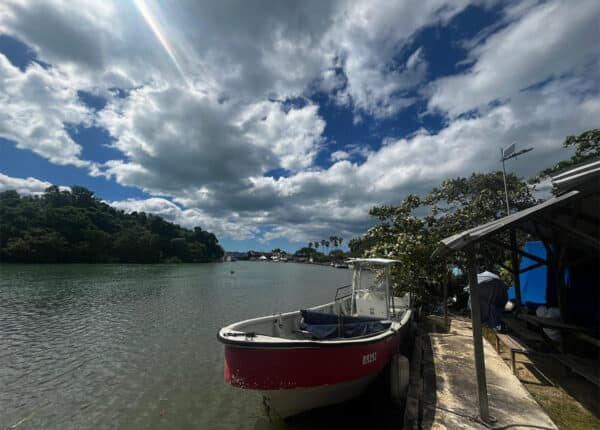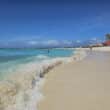Author Carine Fabius on Haiti, Voodoo and Her New Book, “Saturday Comes”
Author Carine Fabius’ literary career has spanned the globe – from an examination of the cross-cultural relationships in France to a look at how indigenous tribes in the Amazon adorn their bodies with the juice of a fruit called the jagwa. Fabius, a native of Port-au-Prince who runs the Galerie Lakaye Haitian art gallery in Los Angeles, has entered new ground in her latest book, Saturday Comes: a Novel of Love and Vodou, a murder mystery (and love story) set in Miami and rich in Haiti’s voodoo culture. Indeed, it’s even co-narrated by Baron Samedi, the spirit of death – but also a much-beloved figure for his boisterous personality. She will be appearing next week as part of a panel of Caribbean writers at the Miami Book Fair. Fabius talked to Caribbean Journal about Saturday Comes, her exploration of voodoo and the challenges of writing fiction.
How did you decide to write Saturday Comes?
I’ve been interested and fascinated with issues of destiny and fate and whether that’s written in stone – whether we have the ability to change that, and the other issues of race and skin color and the class you’re born into and how those factors play such a big role in determining how people are perceived, and the course their lives take. So all of that, in conjunction with the prevailing magic that rules the voodoo culture in Haiti, those things have all been swimming around in my brain or several years. I finally came around to the idea of writing a love story between two Haitian people from opposite sides of the track, and about the inexplicable and mysterious energies that draw human beings together. And that was the story I started out writing, and then one of the characters decided to murder another one, and that meant I had to bring in a detective to investigate, and I was kind of right smack in the middle of writing a murder-mystery investigation.
What motivated that change?
You let characters do what they want, if you’re smart. More specifically, it was about a 12-year-old girl from Haiti who falls in love with a boy from the mulatto and privileged class, and the villain in the story is the boy’s father, who sees what’s happening and he blackmails the girl’s mother into sending her on one of the refugee boats to Miami. The horror of that trip leaves its mark on her in a very traumatic and profound way, and she vows to murder the villain, and so a murder is committed. I decided to make the voodoo spirit of death, whose name is Baron Samedi, a co-narrator. Samedi means Saturday in French or Haitian Creole, and he’s a much-beloved and popular character in Haiti for many reasons. So he plays a part early in the story, when he comes to the mother and tells her that if she lets money rule her and guide her decisions, it means impending disaster for her daughter – so the disasters come to pass, and he helps narrate the story.
The book is mostly set in Miami. What influence did that have on the story?
Well, I loved Miami a lot. I lived there for seven years in the 1980s before moving out to LA, and I’ve gone to Miami many times – whenever I can. I love Miami, and I remember a lot about it, and loved so many parts about it, and there’s the whole issue of the refugee boats landing in Miami, so it just made sense to set it there.
Talk about the power of voodoo in the story.
The detective [investigating the murder] is a Cuban woman who has a Santeria background, which is the religion that is very similar to Haitian voodoo. I was originally writing about the mysterious energies that draw human beings together, and it was these two women I was thinking about even more – they come from different backgrounds – one’s a cop that ends up investigating this Haitian girl who’s got a voodoo background, but they feel drawn to each other, and feel this sympathetic energy toward each other. So that’s how I came up with it.
Did you learn anything new about voodoo in writing the book?
Well, I’m from Haiti, and I was raised Catholic, although I don’t practice any religion now. I’ve always been fascinated by the voodoo culture, especially because it was such a “don’t go there” kind of thing when I was being raised. What got me more familiar with voodoo is that I opened a Haitian art gallery in Los Angeles 20 years ago called Galerie Lakaye, and in the process, through selling a lot of art that was voodoo-related, I learned a lot about it. There’s a pantheon of gods and goddesses that people worship and serve and exchange for guidance and blessings and favours, whatever people pray to god for. And you come to have your favourite spirits based on their characteristics and their personalities, and their offerings. I spent a lot of time explaining to my gallery clients what those symbols were and who the different spirits were and what they’re all about. So I got to like the Baron [Samedi] a lot – for some reason, I liked a lot about him. On the one hand, he’s the spirit of death and this foreboding presence, and he’s scary and all that, but on the other hand, his personality is that he’s so full of life and quite the party animal, and when he comes to a ceremony, that’s when the party begins. He’s lude and lascivious and really a lot of fun, so that how I came to learn more about voodoo – through art.
How is this book different than your previous work?
This was really, really hard for me. This was my first real work of fiction. I’m all over the place when it comes to what I write. My first book was on the art of Henna body painting, and my second was about how to create ceremonies around important events – nothing to do with voodoo but more with the spiritual realm. My third book was called Sex, Cheese and French Fries: Women are Perfect, Men are from France, which was fiction but really based on my adventures in “Frenchland,” because I’m married to a French guy. So that was a humourous look at cross-cultural relationships and their challenges. My last book was about Jagwa, a fruit that grows in the Amazon that indigenous people have been using for centuries for body adornment. I guess I write whatever I feel like, but I’m much more comfortable writing nonfiction, and I mostly blog [at the Huffington Post] about issues related to arts and culture and books and lifestyle, so my nonfiction voice is a lot easier. This was hard, hard work. Making things up is really hard for me!
What do you think about the state of Haitian literature, in the Diaspora and within Haiti?
It seems like it’s growing by leaps and bounds. There’s a lot of work being introduced out there all the time. I’m thrilled, very excited about it.
–CJ Arts







